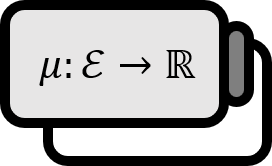Algebra, Quasi-measure
Definition
A collection $\mathcal{A}$ of subsets of a set $X \ne \varnothing$ is called the algebra of sets on $X$ if it satisfies the following three conditions:
(a) If $E_{1}$, $\cdots$, and $E_{n}\in \mathcal{A}$, then $\bigcup \nolimits_{1}^n E_{n} \in \mathcal{A}$ is true.
(b) If $E_{1}$, $\cdots$, and $E_{n}\in \mathcal{A}$, then $\bigcap \nolimits_{1}^n E_{n} \in \mathcal{A}$ is true.
(c) If $E \in \mathcal{A}$, then $E^c\in \mathcal{A}$ is true.
Let’s refer to $\mathcal{A}$ as the algebra on $X$. A function $\mu_{0}\ :\ \mathcal{A} \rightarrow [0,\infty]$ that satisfies the conditions below is called a premeasure:
(d) $\mu_{0} (\varnothing)=0$
(e) If $\left\{ E_{j} \right\}_{1}^\infty$ is a sequence of disjoint sets in $\mathcal{A}$, and $\bigcup \nolimits_{1} ^\infty E_{j} \in \mathcal{A}$, then $$ \mu_{0} \left( \bigcup \limits_{1}^\infty E_{j}\right)=\sum \limits _{1} ^\infty \mu_{0} (E)_{j} $$
Explanation
Here, by replacing condition (a), (b) with countable unions and intersections, it becomes a sigma-algebra. Also, $\varnothing$, $X$ $\in \mathcal{A}$ are valid, which can be easily verified with the above definition. Alternatively, this condition itself might be included in the definition.
If $E \in \mathcal{A}$, then by definition, $E^c \in \mathcal{A}$ is true, and also $E\cap E^c=\varnothing \in \mathcal{A}$. Therefore, $\varnothing^c=X\in \mathcal{A}$
(e) The countable union doesn’t necessarily have to be included back into the algebra, but if it is, it needs to have the countable additivity to that extent.
